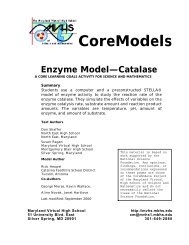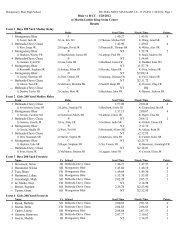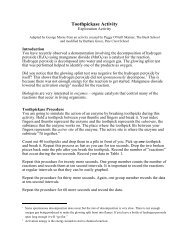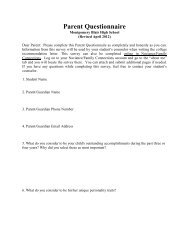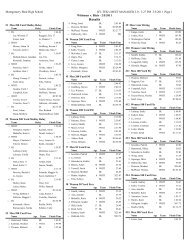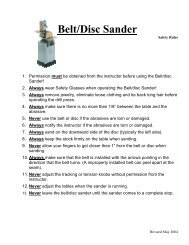The Structure and Function of Enzymes MODULE 1 MODULE 2 ...
The Structure and Function of Enzymes MODULE 1 MODULE 2 ...
The Structure and Function of Enzymes MODULE 1 MODULE 2 ...
Create successful ePaper yourself
Turn your PDF publications into a flip-book with our unique Google optimized e-Paper software.
What are <strong>Enzymes</strong> Made Of?Module 1 Extension Activity<strong>The</strong> discovery that enzymes were made <strong>of</strong> protein was a significant step towarddetermining where they come from.We now know that genes determine the enzymes that we possess in our bodies. When anenzyme is not working properly it infers that the gene has been altered or mutated. Amutation in a gene coding for an enzyme almost always impairs or destroys enzymefunction (Audesirk 1999, page 216).Here are some scenarios <strong>of</strong> conditions that result from genes that code for abnormalenzymes or proteins. Select one <strong>of</strong> the scenarios <strong>and</strong> write an abstract that contains the• name <strong>of</strong> the condition,• number <strong>of</strong> the chromosome that the gene causing the condition is found on, <strong>and</strong>• name <strong>of</strong> the enzyme or protein that causes the condition.Note: Some <strong>of</strong> the scenarios are more difficult to research than others; the teacher maywish to limit the scenarios from which the students can choose.Scenario #1<strong>The</strong> red blood cells <strong>of</strong> a person may appear normal until the person exercises or travels tohigh altitudes. <strong>The</strong> red blood cells may change shape <strong>and</strong> block capillaries, causing pain,stroke, or a heart attack. Some believe that this condition provides resistance to malaria.[<strong>The</strong> condition is sickle cell anemia. Valine is substituted for glutamic acid as the seventhamino acid <strong>of</strong> hemoglobin.]Scenario #2This condition prevents a person from breaking down a certain amino acid. <strong>The</strong> aminoacid, phenylalanine, is converted to other chemicals that accumulate in the bloodstream.<strong>The</strong>se abnormal substances are harmful to infants because they interfere with thedevelopment <strong>of</strong> brain cells. Infants with this disorder suffer severe mental retardation <strong>and</strong>rarely live more than thirty years. When detected early enough, individuals with thiscondition can be given special diets <strong>and</strong> develop <strong>and</strong> mature normally. <strong>The</strong> condition isnot usually harmful to adults (Raven & Johnson 1992, page 270).[<strong>The</strong> disorder is Phenylketonuria. A defective form <strong>of</strong> the enzyme phenylalaninehydroxylase is produced.]Scenario #3This incurable human disease causes a slow, progressive deterioration <strong>of</strong> the brain. Itresults in the loss <strong>of</strong> motor coordination, flailing movements, personality disturbances,<strong>and</strong> eventual death. <strong>The</strong> symptoms typically do not appear until 30 to 50 years <strong>of</strong> age(Audesirk 1999). [<strong>The</strong> condition is called Huntington’s disease. It is on chromosome 4;the gene’s product is a protein dubbed “huntingtin”.]Scenario #4Some people cannot manufacture all <strong>of</strong> the molecules needed for blood to clot properly.This means that they bleed excessively from the slightest wound. <strong>The</strong>re are “clotting16





